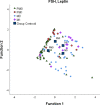Hormonal, metabolic and inflammatory circulating biomarker profiles in obese and non-obese Brazilian middle-aged women
- PMID: 31509577
- PMCID: PMC6738638
- DOI: 10.1371/journal.pone.0222239
Hormonal, metabolic and inflammatory circulating biomarker profiles in obese and non-obese Brazilian middle-aged women
Abstract
Aim: To investigate circulating hormonal, metabolic and inflammatory biomarker profiles in obese and non-obese middle-aged women.
Methods: A total of 110 women, aged 40-60 years, were included in this cross-sectional study. Patients were allocated, according to the occurrence of menopause and body mass index (BMI), into four groups: PM0 (premenopausal non-obese), PM1 (premenopausal obese), M0 (postmenopausal non-obese), and M1 (postmenopausal obese). Serum levels of gonadotropins, sex hormones, lipid markers, leptin, hs-CRP and interleukin-6 were obtained using either colorimetric or immunoenzymatic assays. Univariate and correlation analyses were performed among all clinical and laboratorial parameters. Principal component analysis was used to characterize subsets of biomarkers, which had their discriminatory capacity tested using discriminant function analysis.
Results: Levels of gonadotropins and female sex hormones were similar between PM0 and PM1 and between M0 and M1 (p > 0.05), all of them varied between PM0 and M0 (p < 0.05), but only estradiol was significantly altered in the comparison between PM1 and M1 (p = 0.027). Regarding metabolic markers, leptin was lower in PM0 than in M0 (p = 0.010) and higher in M1 than in M0 (p = 0.046). In premenopausal women, BMI correlated only to leptin, while it correlated to several other markers in postmenopausal women. A combination of FSH and leptin serum levels significantly discriminated the four groups (Wilks's lambda < 0.001, in canonical functions 1 and 2).
Conclusion: A combined analysis of hormonal biomarkers may potentially distinguish obese from non-obese women with distinct menopause status. Further research is thus required to clarify the clinical significance of such findings.
Conflict of interest statement
The authors have declared that no competing interests exist.
Figures



Similar articles
-
Influence of obesity and menopausal status on serum leptin, cholecystokinin, galanin and neuropeptide Y levels.Gynecol Endocrinol. 2000 Jun;14(3):196-203. doi: 10.3109/09513590009167682. Gynecol Endocrinol. 2000. PMID: 10923281
-
Determinants of sex hormone-binding globulin blood concentrations in premenopausal and postmenopausal women with different estrogen status. Virgilio-Menopause-Health Group.Metabolism. 1997 Jan;46(1):5-9. doi: 10.1016/s0026-0495(97)90159-1. Metabolism. 1997. PMID: 9005961
-
Plasma Oxytocin Concentration in Pre- and Postmenopausal Women: Its Relationship with Obesity, Body Composition and Metabolic Variables.Obes Facts. 2018;11(5):429-439. doi: 10.1159/000492001. Epub 2018 Oct 30. Obes Facts. 2018. PMID: 30372704 Free PMC article.
-
A systematic review and meta-analysis investigating differences in chronic inflammation and adiposity before and after menopause.Maturitas. 2024 Dec;190:108119. doi: 10.1016/j.maturitas.2024.108119. Epub 2024 Sep 26. Maturitas. 2024. PMID: 39332331
-
Effects of sex steroid hormones and menopause on serum leptin concentrations.Gynecol Endocrinol. 2002 Dec;16(6):479-91. Gynecol Endocrinol. 2002. PMID: 12626035 Review.
Cited by
-
Role of Melatonin in the Onset of Metabolic Syndrome in Women.Biomedicines. 2023 May 30;11(6):1580. doi: 10.3390/biomedicines11061580. Biomedicines. 2023. PMID: 37371675 Free PMC article. Review.
-
Insulin Resistance: A Marker for Fat-to-Lean Body Composition in Japanese Adults.Nutrients. 2023 Nov 8;15(22):4724. doi: 10.3390/nu15224724. Nutrients. 2023. PMID: 38004118 Free PMC article.
References
-
- Ossewaarde ME, Bots ML, Verbeek AL, Peeters PH, van der Graaf Y, Grobbee DE et al. Age at menopause, cause-specific mortality and total life expectancy. Epidemiology. 2005;16(4):556–562. - PubMed
Publication types
MeSH terms
Substances
LinkOut - more resources
Full Text Sources
Medical
Research Materials
Miscellaneous

